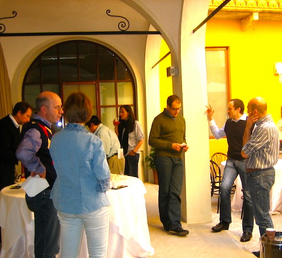It was held in Cremona, organized by Avantea, an important meeting on xenotransplantationt to meet the ever-growing organs need for transplantation and the treatment of degenerative diseases in human.
On the 11th and the 12th April 2011, representatives of 22 science centers world known have discussed the progress of the reaserach of the European project Xenome, which was created to develop preclinical research in the field of xenotransplantation (see the explanation at the end of page), based on the porcine model.
"We are not in Cremona by chance," says prof. Cozzi, a pioneer in the world of xenotransplantation, "We are here because Prof. Gallli’s group is the reference point for the technology of genetic engineering, as in recent years it has reached an high level in the field."
The task of Avantea in the project is of improving compatibility between the organs of the pig model with human, by engineering the animal," adds Professor. Galli "since we have identified molecules that are responsible for the rejection. There are immunological information that are transferred to those who make the animal (and its organs) closer to the man. It is now the third year that we produce engineered pigs for other centers. "
Avantea is therefore the starting point, then, the animals are sent to Belgium for pancreas transplantation at the Catholic University of Louvain, whose referent in Cremona is Pierre Gianello, in France by Jean-Paul Soulillou Institute of Transplantation and research on the transplant INSERM (French National Institute for research), Nantes for kidney transplant; in Padua for the third neuronal transplantation by Emanuele Cozzi Hospital of Padua, who is also the coordinator of the project with a budget of € 10,000,000.00.
In these workshops we try to see if what is served is effective it can be transferred in a clinical context.
In these workshops we try to see if what is done it is is effective and can be transferred in a clinical context. First, says prof. Cozzi project coordinator "we approached xenotransplantation to the clinic, to the patient. Second, the model we have proposed to the European Commission is not the rat, but the swine that is closest to humans. We have chosen the most difficult and we promised the EU that the information that we create are essential for the transplantation. To date, the person who receives a kidney transplant dies within 10-12 years after transplantation in 50% of cases, the liver 15-16 and 12-13 for the heart. The human immunology is extremely difficult: it is essential to study the context of the rejection to perfection. We have a few organs; those transplanted do not last forever and the population ages. For example, a patient dialysis coast to the Italian State € 80,000 €. Here is where xenotransplantation comes. " "The results of Prof. Galli are very advanced" says the French Soulillou "they have the best performance on engineering, best of all 27 partners of the network."
REVOLUTIONARY FRONTIER FOR HUMAN MEDICINE
The term xenotransplantation (from the greek xeno means stranger) is the transplantation of organs, tissues or cells between organisms of two different species.
The most studied animal as an organ donor for human is the pig, as it has anatomical similarity with the human species. The biggest barrier is still that immunological, but several studies are focusing on the development of genetically modified animals in order to overcome some obstacles. However, ethical questions still remain, particularly by animal rights activists, who oppose the idea of creating animals used as a store of organs for humans. From a strictly medical point of view, some doubts about the ability to transmit zoonoses still remain.
The availability of pig organs and cells for the treatment of patients with end-stage organ failure would represent a revolution in human medicine. This possibility has recently become more realistic. Now it has been established that most of the difficulties inherent in the xenograft derived from an important number of fundamental biological processes, in particular those involved in the regulation of the main molecular cascades (such as coagulation and complement).
According to the most recent guidelines of the European Union, xenotransplantation is defined as any procedure that involves:
1. the implantation of transplantation or infusion of a human recipient of organs, tissue or viable cells of animal origin (xenotransplantation of type A);
2. the contact ex vivo of the human body, living cells, tissues or organs of animal origin (xenotransplantation of type B).
In Xenome project, there is also an External Advisory Board, responsible, among other things, of supervising the activities in relation to compliance with ethical and legal principles. In addition, there is a specific work package dedicated to the ethical and legal aspects of xenotransplantation.
From the ethical point of view, it is important to emphasize that the standards of transplantation in the animal field (eg. Monkeys) are much more severe than the standards for transplantation to humans. Ethical conduct is the basis for a solid scientific reputation; Avantea has been following the basic principle of the three Rs:
• Replacement: replace with other methods where it is possible to achieve the same purpose without the use of animals;
• Reduction: use fewer animals;
• Refinement: alleviate and minimize potential pain and suffering for the animals.


